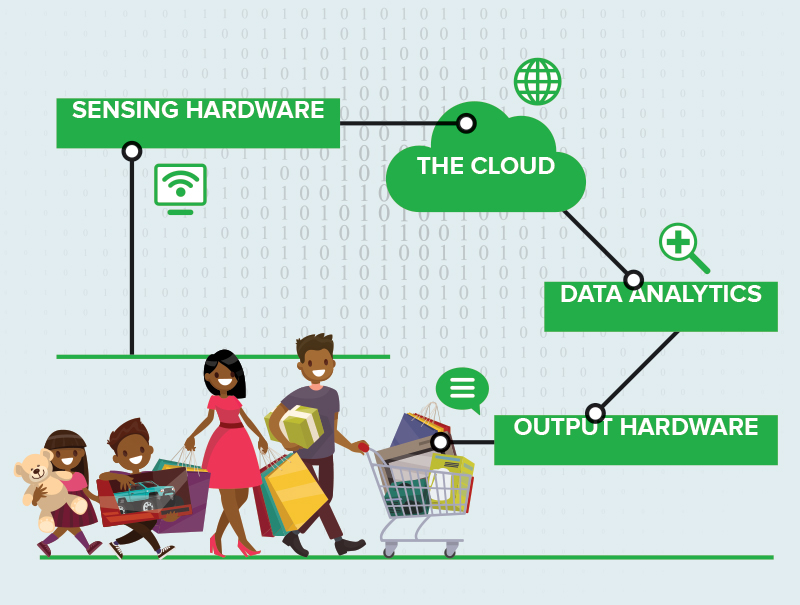Smartphones, video cameras, POS terminals, email providers, websites, cars, watches, thermostats, motion sensors, building security systems and credit card terminals are but a handful of the machines that are collecting information about people’s daily activities, patterns and preferences. The problem is that this information often stays in its operation workflow without changing and improving the consumer behavior and experience. We have not yet fully made the leap from data collection to real-time analysis that distills big data into actionable information.
Very few companies have figured out how to effectively improve a consumer’s experience — in real time — based on information about location, environment, time or the consumer profile. However, we know that the number of merchants testing information-based messaging is growing as they continue to understand the power of targeted advertising.
Ideally, the merchant will want to turn the data into usable, intelligent information to better understand customers, supply chains, employees and product offerings. Then the intelligence turns into real-time action: targeted digital signage messaging, automated inventory purchasing, instant coupons, employee-performance feedback and in-store attach sales.
The primary goal is to properly analyze the data collected to drive measured improvement in the consumer’s overall experience with the retailer. This improvement should then lead to incremental revenue growth.
| From a technology standpoint, there are 4 major components in the process: |
 |
Sensing Hardware. Equipment that collects consumer inputs: smartphones (as personal location and activity sensors), security cameras (collect timestamp data and gender and age bracket), sensors (motion and temperature), POS terminals (collecting consumer purchasing behaviors), beacons (connecting with people’s smartphones), etc.
The Cloud. Where all the data collected from the sensing hardware is stored.
Data Analytics. Where all the data gets analyzed and interaction decisions get made (can be housed in the cloud).
Output Hardware. How the customer gets the desired experience.
The Sensing Hardware
Our focus here is on the sensing hardware. Hardware manufacturers have a huge responsibility as they provide the inputs to big data. As the eyes and ears to the world, they need to ensure that the proper information reaches the data analytics engine. There are four main things the hardware providers need to ensure:
- Data Accuracy
The sensing hardware has to capture correctly the intended information because it is the only way to get the system to provide strong analytics and output. Remember: garbage in, garbage out. Accuracy in time-stamping, location tracking, transaction ID and the actual raw data are key. Thermostats have to be calibrated, cameras need to have strong resolution to capture facial features, motion sensors have to accurately sense time/date and duration of the motion, and POS hardware and software have to correctly deliver transaction data to the cloud.
Hardware manufacturers have to ensure a high level of equipment reliability and compatibility. Down equipment means lost opportunities to affect consumers and a possible loss of ad revenue. VARs should make sure that they are installing professional, highly reliable equipment that collects accurate data — not a discount alternative. Spending less upfront could create downtime for the system and cost more in replacement equipment purchase and lost potential revenue. For example, there are retailers using the security cameras at the front of the store to record the gender, age bracket and timestamp of everyone passing through its doors. The retailer then uses the information to drive messaging in the store and to optimize checkout lane staffing. The data needs to be accurate to ensure that the correct activity is being performed. - Real-Time Data Stream
For the analysis and output to be meaningful, it must be pushing data to the cloud continually. Delays to the flow means that the real-time consumer interaction and activity will not happen at the right time. If the network is down, in-store instant coupons based on customer proximity will not work, dynamic advertising will not be aligned to customer behavior and merchandise could stock-out without inventory visibility.The best deployments in the market are able to sense who is in the store using beacon technology, drive messaging to the consumer’s smartphone, use digital signage to gently suggest complementary sales based on purchase history and offer coupons at checkout. Strong companies also do a good job of managing their entire inventory (in-store, warehouse, transit) by tying it to the analytics engine to ensure that the consumer gets what they want, when they want it.To ensure uptime, the network infrastructure has to be strong. The reseller should be using commercial-grade routers, switches, cabling and servers to build mesh networks to introduce redundancy in the system. They should also add 3G/4G and battery back-up capability if the network could be unstable. A wireless network without sufficient capacity means that only a fraction of the consumers in the store (or a fraction of the fulfillment workers) are transmitting and receiving key information.
- Hardware Agnostic
Hardware manufacturers not only have to ensure accuracy and uptime, they also need to be independent of the cloud and analytics system. They need to anticipate that the merchant is going to continually experiment with their system as they optimize sensor location and efficacy. They will find new and better hardware as technology improves. The assumption is that no single hardware manufacturer will provide all the equipment for a store. Motion sensors, cameras, computers, tablets, displays, thermostats, and beacons may all be made by different companies, but they all need to provide information to a common cloud.The integrator and store IT leadership should verify that all the hardware uses standard protocols for communications: IEEE 802.11, Z-Wave, ZigBee, VESA, MP4, USB, Bluetooth, etc. along with well-defined, well-documented, and simple-to-use APIs that allow developers to quickly integrate a cloud solution with the hardware. Best-in-class hardware manufacturers will have a strong in-house technical services team to work directly with developers and retailer during the pre-sale process and the deployment stage. For smaller merchants, the VAR should do their best to deploy the entire infrastructure instead of using existing equipment, so that they can control the experience. - Show the Vision
Hardware manufacturers tend to be technologists and engineers. This means that marketing is limited to spec sheets, explanation of speeds and feeds and product samples. It is key that the hardware partner provides the developer and retailer a vision for the technology. They should create strong solution demonstrations and stories to help the customer to catch the vision. For example, chipmakers like Intel, Qualcomm and nVidia actually build high-performance computers and tablets to demonstrate the power of their semiconductors. Strong hardware providers will even build small ecosystems to show how the entire consumer experience will lead to increased revenue. For example, GoPro does a great job of making first-person videos — with their cameras — showing people having fun. They do not market the camera: They market the result.
Last Words
Terms like big data and the cloud are meaningless unless they can help you find solutions to your customer’s problems. What are actually important are the actions that the retailers take after they analyze the data. The actions made based on the data analytics are what make the consumer experience special and impactful. The hardware that senses the environment is big data’s window to the consumer, and integrators need to make sure that they are choosing the best equipment possible to enable the system to deliver great experiences to the consumer and incremental revenue to the retailer. Stores will get better at communicating with customers with distributed beacons, at delivering stronger targeted advertising with demographic-sensing cameras and at using POS data to improve operations.
Luis is the Group Product Manager, North America, at EPSON America, Inc.




